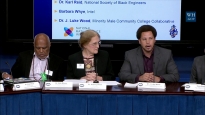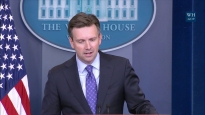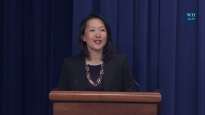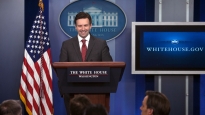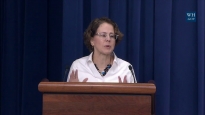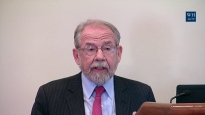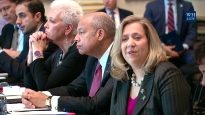President Obama Speaks on Rebuilding Our Infrastructure
May 14, 2014 | 16:05 | Public Domain
President Obama travels to Tarrytown, New York to deliver remarks on the importance of building a 21st-century infrastructure.
Remarks by the President on Building a 21st Century Infrastructure
Washington Irving Boat Club
Tarrytown, New York
3:37 P.M. EDT
THE PRESIDENT: Hello, New York! (Applause.) It turned out to be a beautiful day. Well, it’s wonderful to be here with all of you. Take a seat, take a seat. Relax.
First of all, I want to thank Governor Cuomo for that great introduction and the great job he’s doing. I want to thank Mayor Fixell for having me in Tarrytown. (Applause.) Where’s the Mayor? Where’d he go? There he is, right there. This is a gorgeous part of the world and I am lucky to be here, and I’m going to be coming back soon; in two weeks, I’ve got the honor of delivering the commencement at West Point just a little bit further up.
But today, I’m here, along with our Secretary of Transportation Anthony Foxx -- (applause) -- to talk about one of the best ways to create new jobs and spur our economy, and that is to rebuild America’s infrastructure.
It’s been about five and a half years since the financial crisis that rocked Wall Street and then ultimately spread to Main Street. Thanks to the grit, the determination of the American people, we’ve been steadily fighting our way back. In just four years, our businesses have now created 9.2 million new jobs. Auto industry that was flatlining is now booming. A manufacturing sector that had lost a third of its jobs back in the ‘90s is adding jobs for the first time. Troops that were fighting two wars, they’re either home or coming home. Rather than creating jobs in other countries, more and more companies are recognizing it makes good business sense to locate right here in the United States of America with outstanding American workers. (Applause.)
So we’ve made progress, but here’s the thing: We could be doing a lot more. We could make the decision easier for businesses to locate here in the United States, here in New York state, if we do a better job rebuilding our roads, rebuilding our bridges, upgrading our ports, unclogging commute times. The alternative is to do nothing and watch businesses go to places that have outstanding infrastructure.
And behind me is the old Tappan Zee Bridge, the longest bridge in New York and one of the busiest bridges around. As any commuter will tell you, it is crowded. (Laughter.) It carries a lot more traffic than when it was built back in 1955. At times, you can see the river through the cracks in the pavement. Now, I’m not an engineer, but I figure that’s not good. (Laughter.)
But right now, thanks to the efforts of Governor Cuomo, thanks to your outstanding congressional delegation led by Nita Lowey and including Eliot Engel, and Sean Patrick Maloney, and Jerry Nadler, all of whom are here today -- stand up, congressional delegation. We’re proud of you. (Applause.) Thanks to their outstanding efforts, workers are building a replacement -- the first new bridge in New York in 50 years. It’s called The “New” New York Bridge -- which is fine as a name, but for your next bridge you should come up with something a little more fresh. (Laughter.)
Now, here’s the thing -- this never happens -- you are building this bridge ahead of schedule. Three years ago, after Republicans in Congress refused to pass multiple bills that would have put construction workers back to work, I took action on my own to fast-track the permitting process for major projects like this one. Normally, it would have taken three to five years to permit this bridge; we did it in a year and a half -- in a year and a half. (Applause.) That meant we were creating thousands of jobs faster while doing right by workers and tending to the environment. And the Vice President is in Cleveland today at another project that we fast-tracked -- a rapid-transit station that will make life easier for a lot of residents there.
So today, we’re releasing a new plan to apply the same strategy to other major projects all across America. We’re announcing 11 more projects to accelerate, to get moving faster -- from Boston’s South Station, to Pensacola Bay Bridge, to new light-rail projects north and south of Seattle. We’re cutting bureaucratic red tape that stalls good projects from breaking ground. We’re launching a new national permitting center to implement these reforms. We are aiming to put every major infrastructure project on a public dashboard so everybody can go online; track our progress; hold us accountable; make sure things are coming in on time, on budget; make sure your taxpayer money is being used well, but also make sure that we’re putting folks back to work rebuilding America. That’s our goal. (Applause.)
Now, all these steps we can do without Congress. And all these steps mean more good jobs -- because nobody was hurt worse than construction workers by the financial crisis. The housing market plummeted, and a lot of guys in hard hats and a lot of gals in hard hats, suddenly they were off the job. And that’s why the Recovery Act back in 2009, 2010 included the most important public works jobs program since the New Deal, jumpstarting more than 15,000 construction projects around the country.
Over the past five years, American workers have repaired or replaced more than 20,000 bridges, improved more than 350,000 miles of American roads. Four years ago, when we were just starting to clear away the damage from the financial crisis, the unemployment rate for construction workers stood at 20 percent -- in fact, it was over 20 percent. Today, we’ve cut it by more than half.
But we can do better. We can build better -- and we have to. We’ve got ports that aren’t ready for the next generation of cargo ships. We’ve got more than 100,000 bridges that are old enough to qualify for Medicare. (Laughter.) We’ve got leaky pipes that lose billions of gallons of drinking water every single day, even as we’ve got a severe drought in much of the West. Nearly half our people don’t have access to transit at all. And I don’t have to tell you what some of our airports look like.
Building a world-class transportation system is one of the reasons America became an economic superpower in the first place. But over the past 50 years, as a share of our economy, our investment in transportation has shrunk by 50 percent. Think about that. Our investment in transportation has been cut by half.
You know what other countries are doing? European countries now invest twice as much as we do. China invests four times as much as we do in transportation. One study recently found that over time, we’ve fallen to 19th place when it comes to the quality of our infrastructure -- 19th place. I don’t know about you, but I don’t like America being 19th. I don’t like America being second. I want us to be first when it comes to infrastructure around the world, because businesses are going to come where there’s good infrastructure to move businesses, move people, move services. (Applause.)
We shouldn’t watch the top-rated airports and seaports or the fastest rail lines or fastest Internet networks get built somewhere else -- they need to be built right here in New York, right here in the United States. First-class infrastructure attracts first-class jobs. Business owners don’t want a crumbling road or a bridge because then they can’t move out their stuff, and their workers aren’t as productive because it’s harder for them to get to work. They want to set up shop where there’s high-speed rail and high-speed broadband, high-tech schools, self-healing power grids, new ports, tunnels. That allows them, when they make goods here in America, to move those goods out and sell them all around the world.
Now, unfortunately, helping states and cities fund infrastructure is one of Congress’s chief responsibilities. And you’ve got some outstanding members here, but let me just talk a little bit about Congress right now. If they don’t act by the end of the summer, federal funding for transportation projects will run out -- will run out. There will be no money. The cupboard will be bare. And all told, nearly 700,000 jobs would be at risk over the next year -- that’s like the population of Tampa and St. Louis combined.
Right now, there are more than 100,000 active projects paving roads and rebuilding bridges, modernizing our transit systems. States might have to choose which ones to put the brake on. Some states are already starting to slow down work because they’re worried Congress won’t untangle the gridlock on time. And that’s something you should remember every time you see a story about a construction project stopped, or machines idled, or workers laid off their jobs.
And that’s why, earlier this year, in addition to fast-tracking projects, working with Secretary Foxx, I put forward a plan to rebuild our transportation infrastructure in a more responsible way. It would support millions of jobs across America. It would give cities and states and private investors the certainty they need to plan ahead and invest. And it wouldn’t add to our deficits because we’d pay for it in part by closing wasteful tax loopholes for companies that are shipping jobs overseas that are in the tax code right now and that we could clean out and help pay to put folks back to work rebuilding America. (Applause.)
Now, so far, at least, Republicans who run this Congress seem to have a different priority. Not only have they prevented so far efforts to make sure funding is still in place for what we’ve already got, but their proposal would actually cut job-creating grant programs that have funded high-priority transportation projects in all 50 states. They’d cut them by about 80 percent. And they can’t say it’s to save money, because at the very same time, they voted for trillions of dollars in new tax cuts, weighted towards folks at the very top.
So think about that for a second. Instead of putting more workers back on the job, they’d put those workers’ jobs at risk. Instead of breaking ground on new projects that would improve the quality of life for millions of people, they voted to give a massive tax cut to households making more than $1 million a year. Instead of making investments that grow our economy by growing the middle class, they’re still convinced that prosperity trickles down from the very top.
If you want to tell them what you think about that, don’t worry, because usually they show up at ribbon-cuttings -- (laughter) -- for projects that they refused to fund.
And here is the sad part: Rebuilding America, that shouldn’t be a partisan issue. My favorite President happens to have been a Republican -- a guy named Abraham Lincoln in my home state of Illinois. And it was Lincoln who committed to a railroad connecting East to West, even while he was struggling mightily to hold together North and South. It was a Republican, Dwight Eisenhower, who built the Interstate Highway System. It was Ronald Reagan who said that rebuilding our infrastructure is “an investment in tomorrow that we must make today.” Since when are the Republicans in Congress against Ronald Reagan? (Laughter.)
But that’s part of the problem -- we’ve gotten so partisan, everything is becoming political. They’re more interested in saying no because they’re worried that maybe they’d have to be at a bill signing with me than they are at actually doing the job that they know would be good for America. It’s time for folks to stop running around saying what’s wrong with America; roll up your sleeves and let’s get to work and help America rebuild. That’s what we should be doing. (Applause.)
We don’t need a “can’t do” spirit; we need a “can do” spirit. That’s what Governor Cuomo has, and it sounds like the state legislature was willing to work with him on this. Well, we need Congress to work with us on these issues. It doesn’t mean they’re going to agree with us on everything. I guarantee you they will have more than enough to disagree with me about, but let’s not fight on something we all know makes sense. After all, we’re the people who, in the depths of the Depression, lifted a great bridge in California, and laid a great dam down in the Southwest, and lifted up rural America. We shrank a sprawling continent when we pounded in that final railroad spike, connected up this amazing country of ours; stretched a network of highways all across America from coast to coast. And then we connected the world with our imaginations and the Internet.
A great nation does these things. A great nation doesn’t say “no, we can’t,” it says “yes, we can.” (Applause.)
So the bottom line, Tarrytown, is America doesn’t stand still. There is work to be done. There are workers ready to do it, and some of them are here and they’re already on the job doing the work. We’re proud of them. (Applause.) There are people all across this country that are ready and eager to move this country forward.
So I’m going to keep on fighting alongside all of you to make sure that we’re doing everything we can to rebuild America -- not just rebuild one bridge, but I want us to rebuild every bridge. I don’t want us to just rebuild one school, I want us to rebuild every school that needs help. (Applause.) I want us to most of all, most importantly, rebuild an economy where hard work is valued and responsibility is respected and rewarded, and where opportunity is available not just to some, but to every single hardworking American. That’s what I’m fighting for, and I know that’s what you care about.
Thank you very much, everybody. Good job, workers. I look forward to seeing this bridge. Thank you very much. God bless you. God bless America. Thank you. (Applause.)
END
3:54 P.M. EDT
|
October 28, 2016
|
October 27, 2016
|
October 27, 2016
|
October 26, 2016
|
|
October 26, 2016
|
October 25, 2016
|
October 24, 2016
|
October 24, 2016
|
- &lsaquo previous
- …
- 11
- 12
- 13
- 14
- 15
- 16
- 17
- 18
- 19
- …
- next &rsaquo
